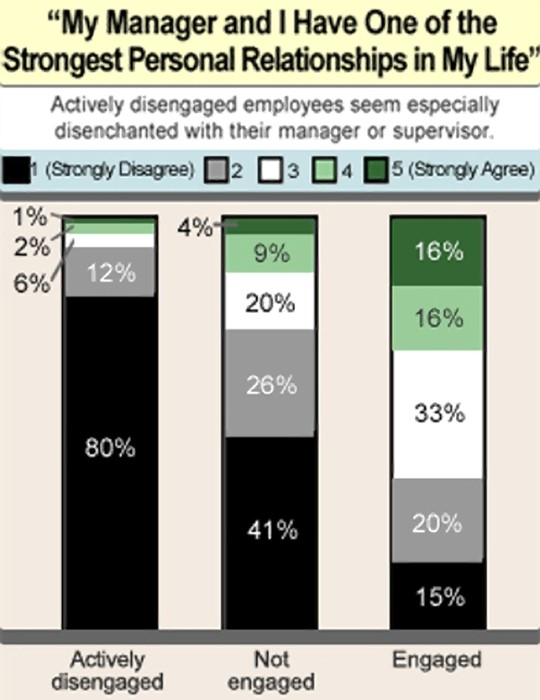Thirty days ago a top executive of a major employee survey company told me…
What Is Employee Engagement? The 2018 Definition

Employee engagement is a hot buzz-phrase that rolls easily off the management tongue…in weekly meetings, when conducting surveys, and in various sessions where HR provides updates on new trends. How Important though, really, is employee engagement? The short answer on a scale of 1 to 10 is 10.
Employee engagement is the lifeblood of every organization. Recruiting, hiring, training, developing, coaching, and retaining teams of employees who bring their best every day is essential for reaching our full organizational potential and out-performing our competitors. Employees who are fully committed to their jobs, leaders, peers, and organizations are essential for reaching short-term goals while also building companies that not only sustain but thrive over time.
Employee Engagement Examples
Compare the best five employees who have ever worked for you against the worst five, and then consider the differences. Here are some flashbacks you’ll see for the best:
- “Gave her best, every day.”
- “Never stopped learning so always contributed more.”
- “Was so dependable I never had to check his work.”
- “His word was golden. Always, always did what he committed to do.”
- “Goal-driven almost to a fault. Achieved every objective, was a finisher.”
The worst five, though, bring different memories like high absences, calling in sick, causing accidents, or missing deadlines with little concern. And here’s another key difference: Engaged employees attract other engaged employees and they like to work together, whereas disengaged employees separate themselves from your best performers, staying to themselves and with others like them. And who knows first which employees are disengaged? Your high performers who drive productivity the most.
What is Employee Engagement?

Simply said, employee engagement is about bringing your best, every day. It’s about employees committing themselves to helping their departments, peers, managers, and organizations to reaching shared goals. Doing so requires passion, high energy, confidence, respect for those they work with, and discipline to stay on track to achieve commitments. We’ve all worked with employees from both ends of the employee engagement scale.
The Gallup organization conducts employee engagement surveys around the world and gives us this carefully-considered description of engaged employees, citing those they say are “engaged”, “not engaged”, and “actively disengaged”:
“Engaged employees are the ones who are the most likely to drive the innovation, growth, and revenue that their companies desperately need. These engaged workers build new products and services, generate new ideas, create new customers, and ultimately help spur the economy to create more good jobs. Actively disengaged employees cost the U.S. between $450 billion and $550 billion each year in lost productivity. They are more likely to steal from their companies, negatively influence their coworkers, miss workdays, and drive customers away.”
And working with engaged employees makes us better. More likely to commute to work with a smile on our face, anticipating successful days where good ideas flow easily, teammates voice solutions instead of problems, and conversations spark fresh thinking to accomplish new challenges. Success is shared and never envied, and celebrations bring team pride with no jealousy.
Engaged employees are the ones who we want to go to lunch with. We gravitate to them because they make us feel better, work better, make our days seem shorter, and ultimately make our careers more successful.
Why Is Employee Engagement Important?
Well-constructed research has pinpointed the dollar value of having an engaged team. Consider these examples and how they apply to the work you and your team do every day:
- Companies with high numbers of engaged employees have 48% fewer safety incidents, 41% fewer quality defects, 37% less absenteeism, and are overall 21% more profitable
- Employee turnover is lower, specifically by 65% in high-turnover organizations and 25% in low-turnover organizations
- Companies with engaged workforces have higher earnings per share as those with an average of 9.3 engaged employees for every actively disengaged employee have 147% higher EPS compared to their competitors
- Another study found a positive relationship between employee engagement and sales growth, lower cost of goods sold, customer focus, and reduced turnover
- And when salespeople give just 10% more effort, customers spend 23% more money
For more information on critical, bottom-line metrics and the impact employee engagement has on profitability, download Dick Finnegan’s whitepaper on “How Much Does Employee Engagement Correlate With Profitability?”
Is Building A Highly-Engaged Team Easy?
 Building an engaged team is not only hard, it is rare.
Building an engaged team is not only hard, it is rare.
According to Gallup, the percentage of engaged employees has remained roughly the same throughout this century, representing about one-third of our total workforce. The remaining two-thirds, then, are what Gallup calls either not engaged or actively disengaged. So a third of our nation’s workforce is pulling the sled for the others, while we invest pay, benefits, training, and more in every employee regardless of their productivity. Companies make great efforts to fix this, spending $1.53 billion each year to improve employee engagement. Or we could say companies flush all those dollars with zero results.
Employee Engagement Surveys
At the heart of these expenses is employee engagement surveys. At first glance engagement surveys seem like a good idea. Why not measure our engagement levels and see how we can improve them? Surveys, though, have become the roadway to high costs with little return.
That roadway usually looks like this:
- Companies search for a vendor to conduct a confidential employee engagement survey
- Companies may choose a vendor based on their databases of comparable benchmark data, particularly in that company’s same industry
- The company then selects the vendor and administrates the survey
- Vendor then sends the survey results, along with benchmark data, with little or no recommendations for improving the scores
- Executives study the survey’s positive items, negative items, and compare all of them plus their overall score to the same-industry benchmarks
- Executives next send each manager her own department results and request an improvement action plan
- Executives ask HR to provide an improvement plan for the organization
- Managers and HR submit their improvement plans as requested
- The CEO then sends an email to all employees, reporting on the survey’s outcome and improvement actions they will see as a result
- Improvement plans are then implemented, with hopes that the next employee engagement survey will yield higher scores
This 1-through-10 employee engagement sequence is repeated by hundreds of thousands of organizations every year, on each of the six inhabited continents. And the dollars invested in engagement survey vendors plus the costs of implementing each of the resulting programs totals to over $1.5 billion in just the U.S. alone. Why is it, then, that employee engagement has not improved for such a long period of time?
The Failed Employee Engagement Strategies

Strategies based on employee engagement surveys fail because they are based on employee programs versus employee relationships.
Most of these mis-directed dollars go to the wide range of employee programs. Think about company activities, celebrations, awards, service anniversary celebrations…and all events with food. Managers and HR are typically responsible for survey improvement action plans so they seek out broad-scale wins. Employee recognition will be solved with employee-of-the-month and service anniversary awards. Communications will be improved with more meetings and videos. Career coaching fixed with “Career Day” and a guest speaker.
Employees usually enjoy these activities but forget about them a few hours later because those hours are spent doing their jobs. Solid research makes clear that the competitive field for solving engagement is within the box of when employees actually work. And the number one reason employees engage or disengage is how much they trust their boss. And that degree of trust is built…or deconstructed…based on how that manager steers each employee through her relationship with that boss, with her colleagues, and with the intricate and challenging parts of her duties. This is where employee engagement lives!
There are other reasons the 10-sequence employee engagement approach fails, too. Executives take too much comfort in comparisons to benchmarks, becoming complacent if their company has scored better than others when the Gallup data clearly shows that few companies actually know how to improve engagement. Secondly, department managers submit improvement plans with no promise of accountability, to the extent that some of them score poorly year after year with no consequences because survey scores for each manager are soon forgotten.
Are There Employee Engagement Best Practices?
There is one best practice and that is you, as the manager of your team. So while organizations search for the next-trendy employee benefit or program, the secret to your employee engagement-building success is staring back at you in the mirror each morning as you prepare for work.
Specifically, Gallup says department managers account for at least a 70% variance of employee survey scores across various teams. Consider their data presented below.

Note first the extremely-worded criteria for this study, “My manager and I have one of the strongest personal relationships in my life”. Then see on the chart that 65% of the engaged employees, the ones we cherish and want to keep, indicate they score their relationships with their managers a 3 or higher on a 5-point scale. The percent of employees who score their manager relationships positively deteriorates from right to left, ending with 92% of the employees Gallup has determined to be “actively disengaged” scoring their manager relationships a 1 or 2.
It is no surprise, then, that employee programs for recognition and communication fail to increase engagement survey scores. The problem is organizations consistently try to solve engagement with “solutions” that work around managers rather than through them. They presume all managers are equally skilled at building relationships, and also that managers have little or no impact on employee engagement…when the precise opposite is true.
How To Improve Employee Engagement
Meet with your employees one-on-one and ask them what you can do to make work better for them. If they want more recognition or communication they’ll tell you. Or if they want more training, specific coaching, or to work more with a peer who they find to be helpful. They’ll also tell you which reports they complete that no one reads, which equipment works better than others, and which colleagues disappoint them with shoddy work. Bring an open mind, too, because they have opinions of your management ways and might share them, good and bad.
By asking, listening, probing, and taking notes, you can then work with them on the spot to identify actions to actually make their work better. In other words, you can move inside that box that matters, the one about bosses, colleagues, and duties. These are the parts of work that matter most to most of us, the ones employees talk about over dinner each night.
The name for this meeting is a Stay Interview. A Stay Interview is a structured, one-on-one meeting between each leader and his employee to strengthen that employee’s engagement and retention. And the top reason Stay Interviews work to improve engagement and retention is because they build trust.
Your Next Step: Conduct Stay Interviews to Build A Highly-Engaged Team
C-Suite Analytics provides all of the information and tools you need to implement Stay Interviews and other business-driven tools to improve employee engagement. Doing so means more than raising a survey score as increased engagement drives more productivity along with more work satisfaction and retention for your team. And that highly-engaged team fortifies your own performance, leading to day-to-day achievements and long-term career success.



